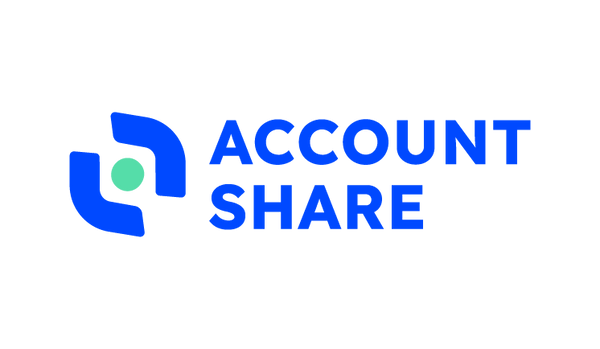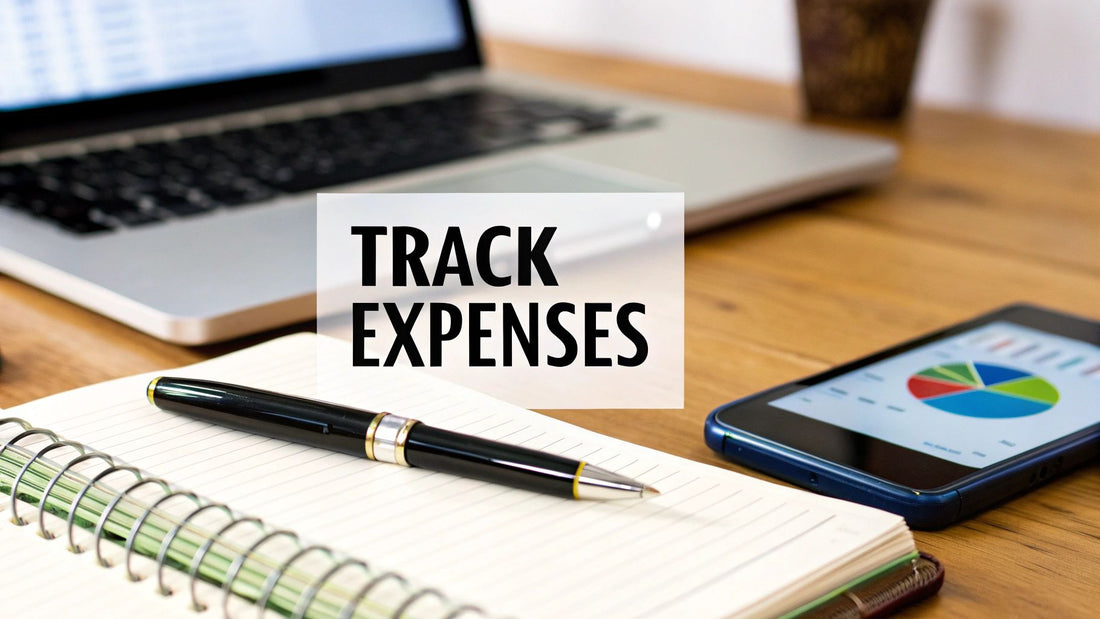
How to Track Monthly Expenses for Financial Clarity
Share
At its core, tracking your monthly expenses is about a simple, repeatable process: pick a tool you like (an app or a spreadsheet will do), sort your spending into categories, and then—this is the important part—actually look at the data. This habit brings a ton of clarity, helping you make smart, deliberate decisions with your money instead of just guessing where it all went.
Why Tracking Expenses Is Your Financial Secret Weapon
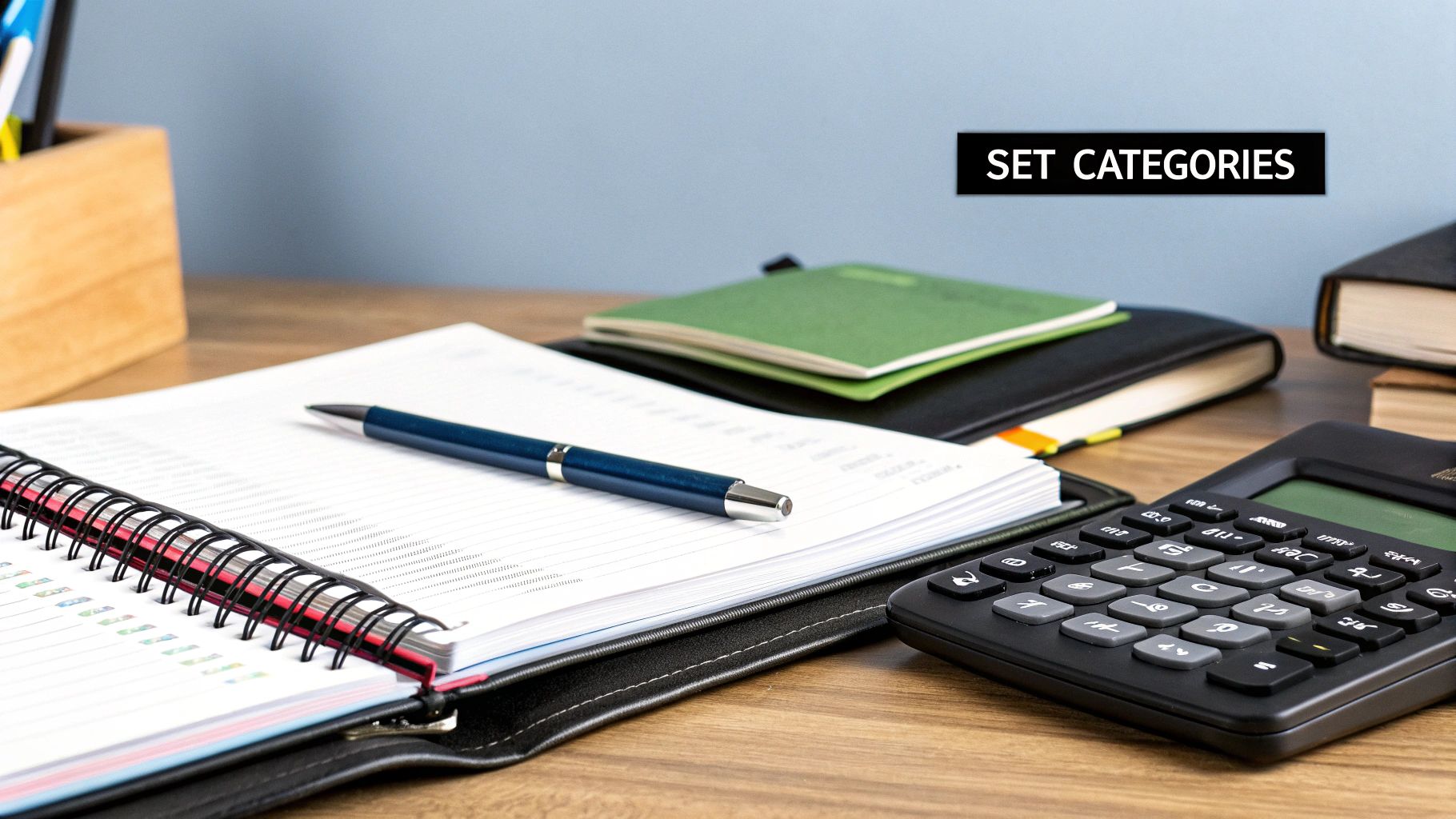
Let's be honest, the thought of tracking every dollar can sound about as fun as a strict diet. But what if it’s the exact opposite? What if, instead of restricting you, it’s the very thing that gives you real freedom and control?
Knowing precisely where your money goes is the first step in making it work for you. It’s about ending that low-grade hum of financial stress that so many of us live with.
Think about it. Maybe you guess you spend around $30 a month on subscriptions. But when you actually add up all the streaming services, software tools, and those free trials that quietly started charging you, the real number is closer to $95. That "aha!" moment is where the magic happens. It isn't about feeling bad; it's about gaining awareness. And that awareness is what shifts your financial life from reactive to proactive.
Gain Clarity and Ditch the Stress
The biggest win here is clarity. Plain and simple. Instead of getting to the end of the month wondering where your paycheck vanished, you have a clear map of your spending habits. That knowledge is incredibly empowering and does wonders for cutting down on money-related anxiety. The same principles that guide successful cash flow management for small business apply right here to your personal finances—it's all about understanding what comes in versus what goes out.
Make Spending Decisions You Actually Feel Good About
Once you can see the patterns, you can start making choices that truly line up with what you want out of life. The point isn’t to slash and burn every fun thing from your budget. It’s about making sure your spending reflects what’s most important to you. For a deeper dive into practical methods, check out our other guide on how to https://accountshare.ai/blogs/new/track-spending and build a system that sticks.
The real goal of tracking expenses isn’t to restrict yourself—it’s to empower yourself with data. You can't optimize what you don't measure, and your personal finances are no exception.
This isn’t just a personal exercise; it’s a crucial skill in a changing economy. For instance, recent data from Australia showed household spending ticked up by 0.5%, driven by rising transport and health costs, while spending on things like clothing dropped. This is a perfect real-world example of how tracking spending by category helps people see exactly where the pressure is and adjust their budgets accordingly.
Finding the Right Expense Tracking Method for You
Choosing how to track your monthly expenses is a lot like picking a workout routine—the "best" one is the one you’ll actually stick with. There's no one-size-fits-all answer here. The goal is to find a system that feels natural and fits into your life, not something that becomes another dreaded chore on your to-do list.
For some people, especially busy professionals, an app that syncs directly with bank accounts is a lifesaver. These tools do all the heavy lifting, automatically importing and categorizing what you spend. It's a "set it and forget it" approach that values efficiency above all else. You might pay a small subscription fee, but the convenience is often worth every penny.
On the other hand, maybe you want to be more hands-on. An app that requires you to manually enter each purchase forces you to pause and really see where your money is going. That small moment of friction can be a surprisingly powerful tool for cutting back on impulse buys. And if you're sharing finances with a partner, finding a great shared expense tracker app is non-negotiable for keeping things clear and avoiding arguments.
Digital Convenience vs. Analog Simplicity
Of course, apps aren't the only game in town. The humble spreadsheet is still a powerhouse for anyone who loves control and customization. If you enjoy tinkering and building a system from scratch, a spreadsheet gives you total freedom to create the exact categories, formulas, and reports you want. It takes more work upfront, but you end up with a system perfectly tailored to your financial life.
Then there’s the tried-and-true pen-and-paper method. For those of us who feel a bit of digital fatigue, using a simple notebook offers a focused, tactile experience. The physical act of writing down what you spend can forge a much stronger mental connection to your financial habits. It's simple, private, and doesn't require a single update.
No matter which tool you choose, the key is integrating it into your daily life, even when you're on the move.
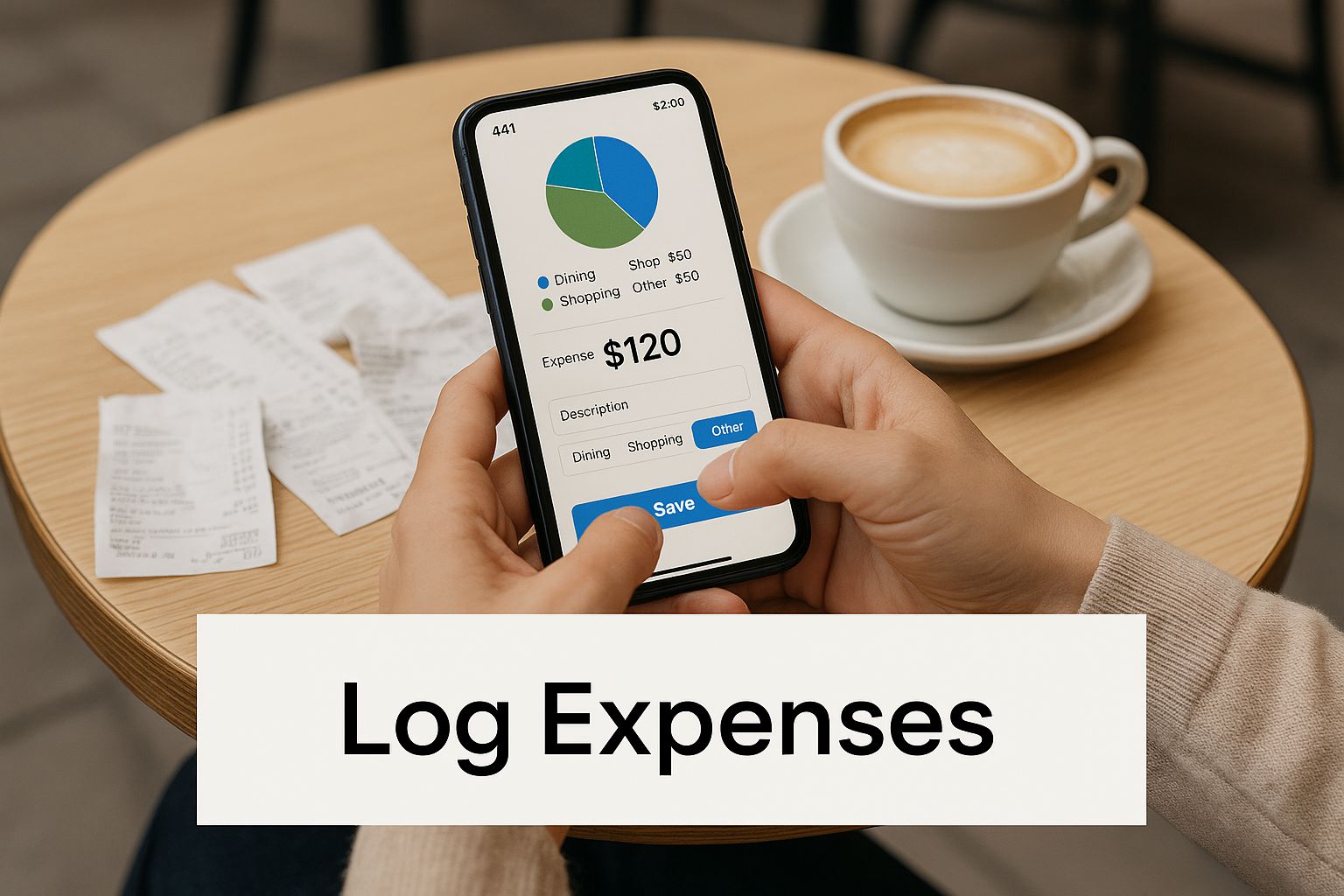
The ability to quickly log that morning coffee or track an online purchase is what makes a system work long-term.
To make the decision a bit easier, here's a side-by-side look at how these popular methods stack up.
Comparison of Expense Tracking Methods
| Method | Best For | Pros | Cons |
|---|---|---|---|
| Automated Apps | The busy professional or anyone wanting maximum convenience. | Saves time, reduces human error, provides a real-time overview. | Often requires a subscription fee, less hands-on engagement with spending. |
| Manual Apps | Individuals who want to build mindful spending habits. | Forces you to confront each purchase, increases financial awareness. | Can be tedious to maintain, easy to forget to log expenses. |
| Spreadsheets | The detail-oriented person who loves customization. | 100% customizable, no cost, powerful data analysis capabilities. | Steep learning curve, requires significant initial setup and manual entry. |
| Pen and Paper | The digital minimalist or anyone seeking simplicity. | Tactile and screen-free, promotes mindful spending, completely private. | Prone to errors, difficult to analyze trends, not easily backed up. |
Ultimately, the pros and cons are personal. What one person sees as a tedious chore, another sees as a valuable exercise in mindfulness.
Making a Choice You Can Live With
The key here is sustainability. If a system feels like a burden, you'll drop it within a month. Think about your own life:
- The Busy Parent: Automation is your best friend. An app that syncs with your accounts ensures nothing slips through the cracks when you have a million other things to worry about.
- The Meticulous Budgeter: A spreadsheet gives you the granular control you crave. You can build custom charts and dive deep into your spending data.
- The Digital Minimalist: A notebook provides a straightforward, focused alternative that helps build a healthier relationship with your money.
The right tool is the one that removes friction. If logging an expense feels like too much work, you just won't do it. My advice? Try one method for a couple of weeks. If it isn't clicking, don't be afraid to switch.
To get started, it can be helpful to see what's out there. Exploring some of the best expense tracker apps might give you a better feel for the features that matter most to you. The goal is to find a financial partner for the long haul, not just a temporary fix.
How to Set Up Your Expense Categories for Real Insight
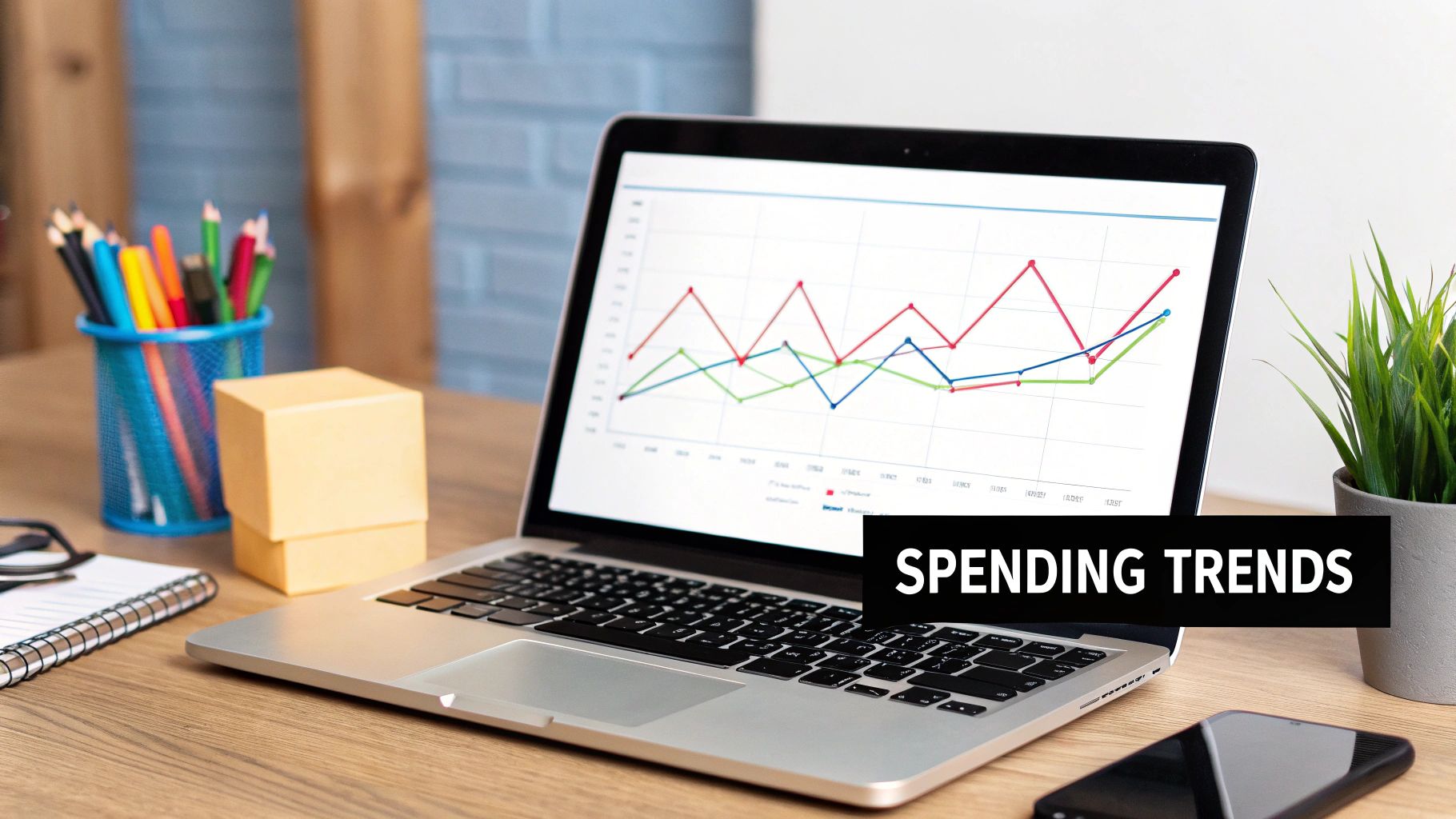
Tracking expenses isn’t just about logging every coffee you buy—it's about organizing that spending so it tells you a story. Creating smart, personalized categories is what transforms a boring list of transactions into a powerful tool for seeing where your money actually goes.
Generic categories are an okay starting point, but the real magic happens when you customize them to your life. The goal is to build a system that’s detailed enough to give you clarity but simple enough that you won't dread using it. I’ve found the best way to start is by sorting everything into three main buckets.
The Three Core Expense Types
Think of these as the foundation of your entire tracking system. Pretty much every dollar you spend will fit into one of these groups.
-
Fixed Expenses: These are the predictable bills that show up like clockwork every month. We're talking rent or mortgage payments, car loans, insurance premiums, and any subscriptions you can't live without. They rarely change, which makes them the easiest to track.
-
Flexible Expenses: This is where most of your day-to-day spending happens. These costs are necessary, but the amounts can vary. Groceries, gas for your car, and utilities all fall under this umbrella.
-
Lifestyle Expenses: This is all the “fun” stuff. Sometimes called discretionary spending, this category covers everything from dining out and entertainment to hobbies, travel, and shopping for non-essentials.
Why Subcategories Are a Game-Changer
Here's where you start to get the real, actionable insights. A broad category like "Utilities" for $350 doesn't really tell you anything useful. It’s just a number. But when you break it down, the picture becomes much clearer.
For example, that $350 "Utilities" category could be split into:
- Electric: $150
- Water: $60
- Internet: $80
- Natural Gas: $60
Instantly, you can see your electricity bill is the biggest piece of that pie. Maybe it’s time to look at your usage, or perhaps you can shop around for a different provider. It's this level of detail that lets you make targeted changes. This is the same principle businesses use; they rely on different cost allocation methods to get a true picture of their operational spending.
The same logic applies everywhere. Instead of a vague "Food" category, try splitting it into "Groceries" and "Restaurants." Instead of just "Shopping," break it down into "Clothing" and "Household Goods."
The perfect category system is one that aligns directly with your financial goals. If you're trying to cut back on impulse buys, creating a specific 'Coffee Shops' or 'Online Shopping' category makes that spending impossible to ignore.
A great way to figure out your own categories is to pull up your last month of bank or credit card statements. Go through each transaction and start sorting. You’ll quickly see which areas of your spending need more detail and which ones can stay broad. It’s a fantastic exercise that not only helps you build your system but also gives you an immediate snapshot of your financial habits.
Don't feel pressured to get it perfect on day one. You can always add, merge, or rename categories later. The whole point is to create a structure that feels intuitive to you and gives you the clarity you need to master your money.
Building the Daily Habit of Capturing Your Spending
Let’s be honest: the fanciest app or most beautiful spreadsheet means nothing if you don't actually use it. The real magic behind successful expense tracking isn't about finding the perfect tool—it's about building the habit of using it consistently. Turning this into a regular routine is what transforms it from a dreaded chore into an empowering part of your day.
The key is to make the process as easy and seamless as possible. You don't need to set aside a huge chunk of time every day. Instead, try creating a five-minute "money moment" for yourself in the evening. Before you start to relax, just pull up your tracker and log what you spent that day. This tiny ritual, practiced daily, saves you from the headache of trying to recall a week's worth of purchases later on.
Making Every Transaction Count
One of the biggest pitfalls is forgetting those small, spontaneous purchases—the morning coffee, the vending machine snack, the impulse buy at the checkout counter. These little "leaks" can add up to a surprising amount by the end of the month. The best defense is to use your phone to your advantage right there in the moment.
Here are a few tricks I’ve found work well:
- Scan Receipts Instantly: A lot of budgeting apps have a receipt scanning feature. Just snap a quick picture right after you pay, and the app often pulls the key details for you. It takes two seconds.
- Use a Simple Note: If you pay with cash, immediately open a basic notes app and jot down "Coffee - $4.50." You can easily move this over to your main tracker during your evening check-in.
- The Pocket Method: For those who prefer a less digital approach, just dedicate one pocket for all your receipts. At the end of the day, emptying that pocket becomes your financial to-do list.
The real goal here is to shrink the time between when you spend the money and when you record it. The shorter that gap, the less you'll forget, and the more accurate your financial picture will be.
Don't Forget to Track Your Income
Tracking what goes out is only half the battle. To get a true, complete picture of your financial health, you have to log your income as it arrives. This means everything: your main paycheck, earnings from a side hustle, that birthday money from your aunt—all of it. Knowing your total monthly income gives you the context you need to evaluate your spending.
This isn't just a personal finance tip; it's a fundamental economic principle. For example, recent household income and expenditure data from China revealed that in the first half of the year, the per capita disposable income was 21,840 yuan, while the average consumption expenditure was 14,309 yuan. This data perfectly illustrates the relationship between what comes in and what goes out. You can learn more about these national household finance trends to see how this plays out on a larger scale.
By logging both your income and your expenses, you stop being a passive observer of your spending and start actively managing your cash flow.
Alright, you've spent a month dutifully logging every coffee and subscription renewal. Now what? This next part is where the real magic happens—turning all that raw data into actual financial progress.
Think of your monthly review less as a report card for your past spending and more as a strategy session for your future self. It's your dedicated time to sit down with the numbers and get honest. Where did the money really go? Did your spending actually line up with what you care about? What were the big surprises?
This isn't about guilt. It's about clarity. Getting proactive here transforms expense tracking from a tedious chore into your most powerful tool for building wealth.
Your Monthly Review Game Plan
To make this process productive and not just a sea of numbers, it helps to have a simple game plan. This ensures you’re hitting the key points and pulling out insights you can actually use.
-
Pinpoint Your Top 3 Spending Categories: Ignore the big, fixed stuff like your rent or mortgage for a second. Where did most of your flexible cash go? Was it groceries? Dining out? That hobby you've been pouring money into? Knowing your top three tells you exactly where small adjustments will have the biggest effect.
-
Look for Sneaky Trends: How does this month stack up against the last one? Is that grocery bill slowly creeping higher? Did you spend more on gas? Catching these patterns early means you can nip them in thebud before they snowball into major budget-busters.
-
Run the Ultimate Reality Check: This is the moment of truth. Add up everything you spent and subtract it from your total income for the month. That single number—whether it's positive or negative—is the clearest indicator of your financial health.
Looking at your own numbers in a vacuum can be tricky, so sometimes it helps to see how they compare to broader averages. For instance, Bhutan’s Household Consumption and Expenditure Survey found the average monthly household expenditure was Nu 54,387. While you shouldn't live and die by these benchmarks, they can offer some useful context. You can dig into more global household spending trends from the nsb.gov.bt report if you're curious.
From "Oops" to "Aha!": A Real-World Example
Let’s make this real. Imagine a friend, Alex, finishes their first monthly review. After paying bills and putting money into savings, Alex has a discretionary budget of $1,000 for everything else.
As Alex looks through the data, one category jumps out: $200 on ride-sharing apps. That's a whopping 20% of their fun money! It wasn't some big, extravagant trip. It was the slow, steady drip of $10 and $15 rides here and there that really added up.
Seeing that total in black and white is the "aha!" moment. The goal isn't to feel bad about it. The goal is to finally see a pattern you never realized was there. This is the first, crucial step to making a real change.
Now, armed with this information, Alex can create a simple, actionable plan for next month. It doesn’t have to be some extreme, all-or-nothing resolution. It could be as simple as:
- Take the subway to work at least three times a week.
- Save the ride-sharing for weekend nights out.
- Set a hard budget of $100 for that category next month and stick to it.
And that is the whole point of this exercise. You're not just tracking numbers for the sake of it. You're identifying a specific problem, seeing its true impact, and then creating a targeted, realistic plan to fix it. You’re no longer guessing where your money went—you're making informed choices based on your own life.
Have Questions About Tracking Your Monthly Expenses? Let's Get Them Answered
Starting a new money habit is bound to bring up some questions. It's totally normal to wonder if you're on the right track or what to expect when you first start looking at your spending this closely. I've heard these same questions from countless people over the years, so let's clear them up and get you moving forward with confidence.
How Long Before I Actually See Results?
You'll get a pulse on your spending in the very first month, which is great, but the real magic happens over time. Give it at least three to six months to get a truly accurate picture.
Why so long? Because that's enough time to move past the daily coffee runs and see the bigger, less frequent costs that can really rock the boat. Things like:
- Annual software or app renewals that sneak up on you.
- Quarterly car insurance payments.
- Holiday or birthday spending sprees.
- That surprise car repair bill.
Think of month one as your financial "before" photo. The months that follow reveal the true story, showing you patterns you'd never notice otherwise.
What's the Best Way to Handle Shared Expenses?
Money can get complicated with a partner or roommate, but it doesn't have to be. The key is to make things clear and simple. Many couples find that opening a dedicated joint bank account for household bills—rent, utilities, groceries—is the easiest path. All shared costs come from one pot, so there's no guesswork.
Another fantastic option is an app built for this, like Splitwise. You just log a bill as you pay it, and the app does the math on who owes what. If you're more of a spreadsheet person, just add a simple column to your tracker. Label each expense 'Shared,' 'Yours,' or 'Theirs.' At the end of the month, you can filter and see exactly who paid for what. No more confusion.
How Do I Stop Forgetting to Log My Cash Purchases?
Ah, the infamous cash purchase. It's the number one thing that trips people up, but a good system makes it easy to remember. The old-school "receipt-in-pocket" trick still works wonders. Pick a pocket, and make it the dedicated home for every single cash receipt. Then, make it a daily ritual to empty that pocket and log everything during your evening review.
No receipt? No problem. Pull out your phone right after you pay. Open a simple notes app and type what you bought and how much it cost. It takes maybe ten seconds. That tiny habit is the bridge that keeps those small cash expenses from falling through the cracks and messing up your otherwise perfect tracking.
Ready to slash your monthly subscription bills without sacrificing your favorite tools and shows? With AccountShare, you can legally and securely share the cost of premium accounts for streaming, software, and AI. It's a game-changer for saving money. Check out https://accountshare.ai and see what you could be saving.
